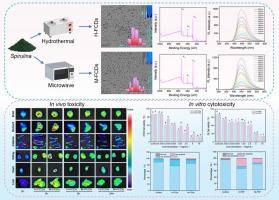热处理螺旋藻的碳点:性质、生物分布和细胞毒性
IF 9.8
1区 农林科学
Q1 CHEMISTRY, APPLIED
引用次数: 0
摘要
食源性碳点(FCDs)是热加工食品中普遍存在的纳米颗粒,因其潜在的健康风险而受到关注。本文采用水热法(H-FCDs)和微波法(M-FCDs)从螺旋藻中提取FCDs,并对其性质、生物分布和生物毒性进行了研究。结果表明,H-FCDs比M-FCDs具有更高的氮含量、量子产率、荧光稳定性和更小的分子量。体内实验表明,FCDs可分布于小鼠肠、肾、肝和脑,但在2 g/kg剂量下无明显急性毒性。体外研究表明,FCDs可被HT29和C6细胞内化,诱导氧化应激,破坏Ca2+稳态和线粒体膜电位。此外,与M-FCDs相比,H-FCDs显著上调Bax,下调Bcl-2,促进Cyt-C的释放,激活Caspase-3,从而诱导HT29细胞凋亡。这些发现为热加工螺旋藻食品中FCDs的潜在健康风险提供了见解。本文章由计算机程序翻译,如有差异,请以英文原文为准。

Carbon dots from thermally processed Spirulina: Properties, biodistribution and cytotoxicity
Foodborne carbon dots (FCDs) are ubiquitous nanoparticles in thermally processed foods that have received attention for potential health risks. Herein, FCDs were extracted from Spirulina by hydrothermal (H-FCDs) and microwave (M-FCDs) methods, and their properties, biodistribution, and biotoxicity were explored. The results showed that H-FCDs had higher nitrogen content, quantum yield, fluorescence stability, and smaller molecular weight than M-FCDs. In vivo experiments indicated that FCDs could distribute in intestine, kidney, liver, and brain of mice, but caused no obvious acute toxicity at 2 g/kg. In vitro studies showed that FCDs were internalized by HT29 and C6 cells, inducing oxidative stress, disrupting Ca2+ homeostasis, and mitochondrial membrane potential. Besides, compared with M-FCDs, H-FCDs significantly upregulated Bax, downregulated Bcl-2, promoted the release of Cyt-C, and activated Caspase-3, thereby inducing apoptosis in HT29 cells. These findings provide insights for the potential health risks of FCDs in thermally processed Spirulina foods.
求助全文
通过发布文献求助,成功后即可免费获取论文全文。
去求助
来源期刊

Food Chemistry
工程技术-食品科技
CiteScore
16.30
自引率
10.20%
发文量
3130
审稿时长
122 days
期刊介绍:
Food Chemistry publishes original research papers dealing with the advancement of the chemistry and biochemistry of foods or the analytical methods/ approach used. All papers should focus on the novelty of the research carried out.
 求助内容:
求助内容: 应助结果提醒方式:
应助结果提醒方式:


